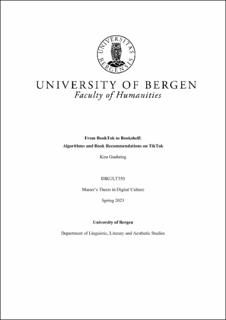| dc.description.abstract | TikTok, a social media platform focused on short-form videos, is gaining a reputation for renewing interest in books (Bateman 2022; Harris 2021). While reviewing and recommending books is not new, the ability to do so on a large scale used to be limited to a select group of critics. Social media allows readers to voice their opinions, and by gaining followings these readers can then influence at a similar scale as traditional reviewers. This raises various questions as to how culture is created and curated. Today, this curation is done largely by algorithms through recommending and promoting content. The rise of BookTok emphasizes this, combining recommendations with TikTok’s algorithm to boost the popularity of certain books. In particular, BookTok has made headlines by repeatedly raising backlist books back onto the bestseller lists. This increases the shift from traditional curators of culture to a community of fellow readers, which can in turn popularize specific genres. Thus, the main question this thesis aims to answer is: what distinguishes BookTok from other digital platforms, enabling it to have such a cultural impact going beyond the online book community? The BookTok phenomenon will be explained by using a mixed-method approach looking at how creators use platform affordances, aesthetic features, and their algorithmic imaginaries to appeal to both users and the TikTok algorithm. The data used in this thesis consists of 148 BookTok videos gathered over a two-week period from the “For You” page. A content analysis was conducted to find patterns in the construction of the videos, the use of specific aesthetic features, and the selection of recommended book titles. Based on this data, it was possible to detect and describe different genres of BookTok videos and to identify the use of relevant platform affordances. This was complemented by a thematic analysis of interviews with three video creators, selected from the authors of the material in the dataset. The interviews gave insight into the algorithmic imaginary of the creators and how the construction of the algorithm informs the creative process. The analysis showed that while the algorithm is what makes the recommendations popular by distributing them to a receptive audience, the TikTok format is what makes the recommendations memorable and has a positive impact on book sales. As the algorithm informs every aspect of the book recommendations, from the creator’s decisions of picking a certain book to the decisions on when to make the video and who the algorithm subsequently recommends the video to, the book recommendations on BookTok can be examined as examples of algorithmic curation. By taking up the topic of literature and literary readership from a digital culture perspective, this thesis aims to contribute to the greater discussions on algorithms, personalization, and its’ effect on cultural production and curation. | |
